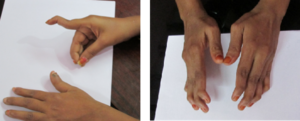
Image type: Swan neck deformity
Body site: Fingers
Description: Swan neck deformity is a condition that affects the joints in the fingers, leading to serious physical impairment. In this condition, the middle joint of a finger is extended (bent back) more than normal, while the end joint is bent down. Swan neck deformity is characterized by hyperextension of the proximal interphalangeal (PIP) joint and flexion of the distal interphalangeal (DIP) joint, along with reciprocal flexion of the metacarpophalangeal (MCP) joint. This imbalance results from laceration or stretching of the tendon forces on the distal phalanx or from tightness and pulling of the extensor mechanism at the PIP joint.
Causes: Swan neck deformity can arise from various conditions. Rheumatoid arthritis (RA) is a common cause, where joint inflammation stretches the soft ligaments and capsules, disrupting the proper alignment of joints and tendons. Untreated mallet finger, or “baseball” finger, can also lead to swan neck deformity. This condition involves the loss of the ability to extend or straighten the distal DIP joint, resulting in an imbalance of tendons and ligaments that affects the PIP joint. Additionally, some individuals are born with a congenital swan neck deformity. Ehlers-Danlos Syndrome (EDS), a connective tissue disorder characterized by joint hyperflexibility, is another significant cause. Individuals with EDS may experience progressive issues with hand function due to their hyperflexible joints. Lastly, some people with naturally loose or lax joints, often referred to as “double-jointed,” may develop swan neck deformity in severe cases.
Symptoms: Swan neck deformity exclusively affects the fingers of the hand, and the symptoms can vary depending on the stage of the condition. Initially, individuals may notice a slight change in the bending of one or more finger joints. Early symptoms often include joint pain, especially when bending the finger joints. As the condition progresses, the symptoms become more pronounced. In the later stages, the deformity becomes recognizable, with the PIP joint hyperextending and the DIP joint flexing, causing the finger to resemble a swan’s neck.
Differential diagnosis
Boutonniere deformity may be confused with swan neck deformity. It is important to note that boutonniere deformity involves hyperextension of the DIP and flexion of the PIP, whereas swan neck deformity is the opposite.
Treatment
Treatment options for Swan Neck deformity vary based on the cause and rigidity of the deformity. Non-invasive treatments include specialized rings for the middle joint to correct its position and prevent snapping. In more severe cases, surgical options may involve preventing excessive extension of the middle joint or repositioning tendons. If the middle joint is stiff or arthritic, joint replacement or fusion in a slightly bent position may be necessary. Consulting a hand surgeon is crucial to determining the best treatment plan, which could be non-surgical or surgical depending on the specific case.

You must be logged in to post a comment.